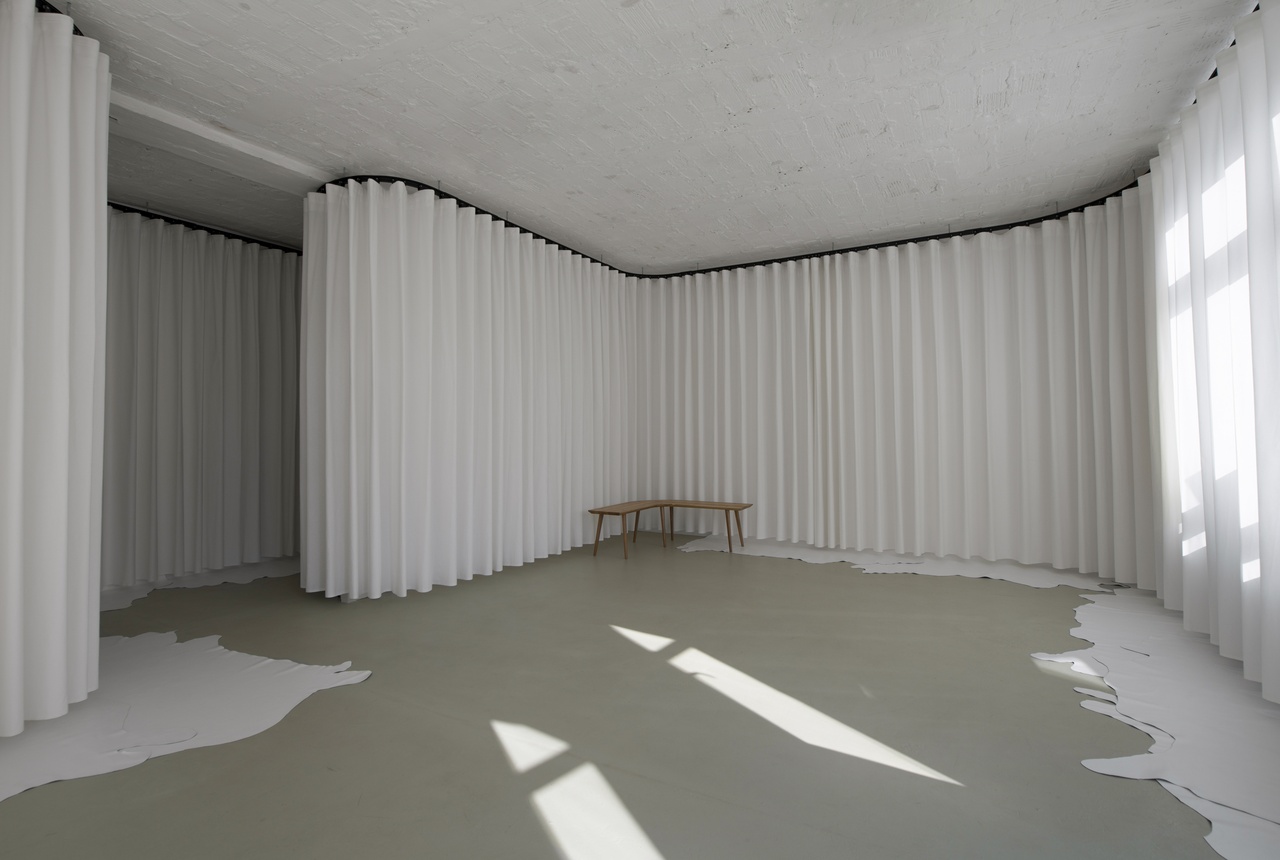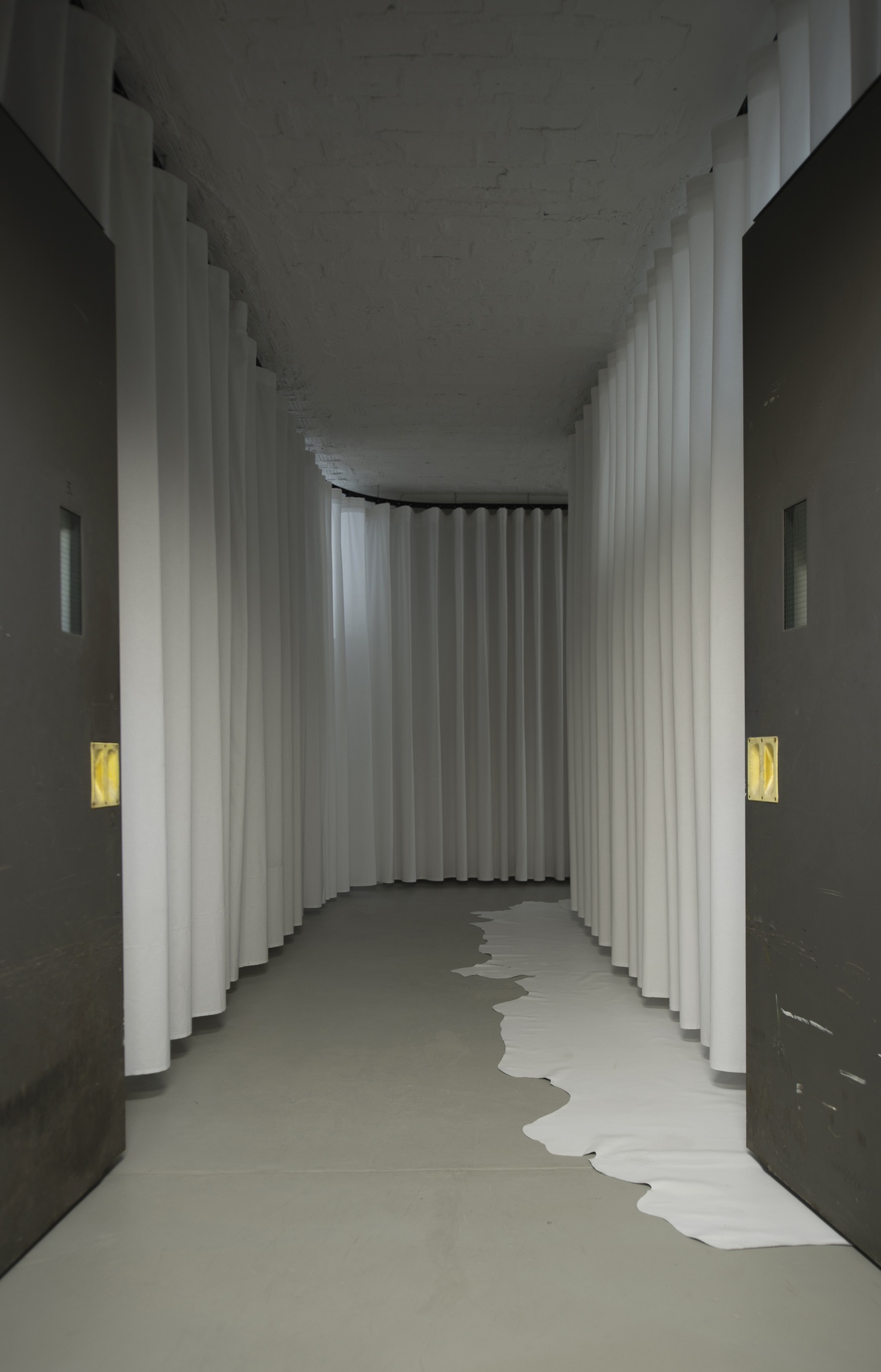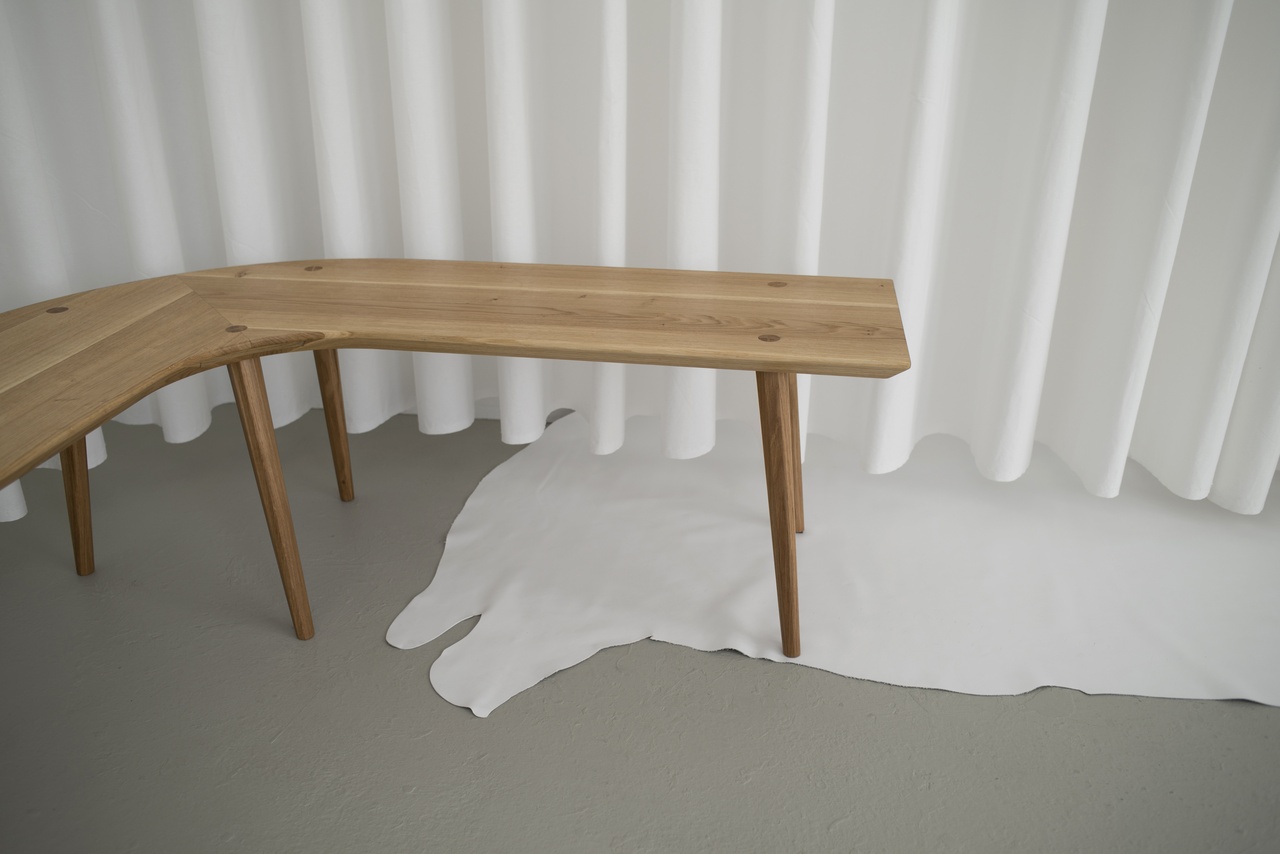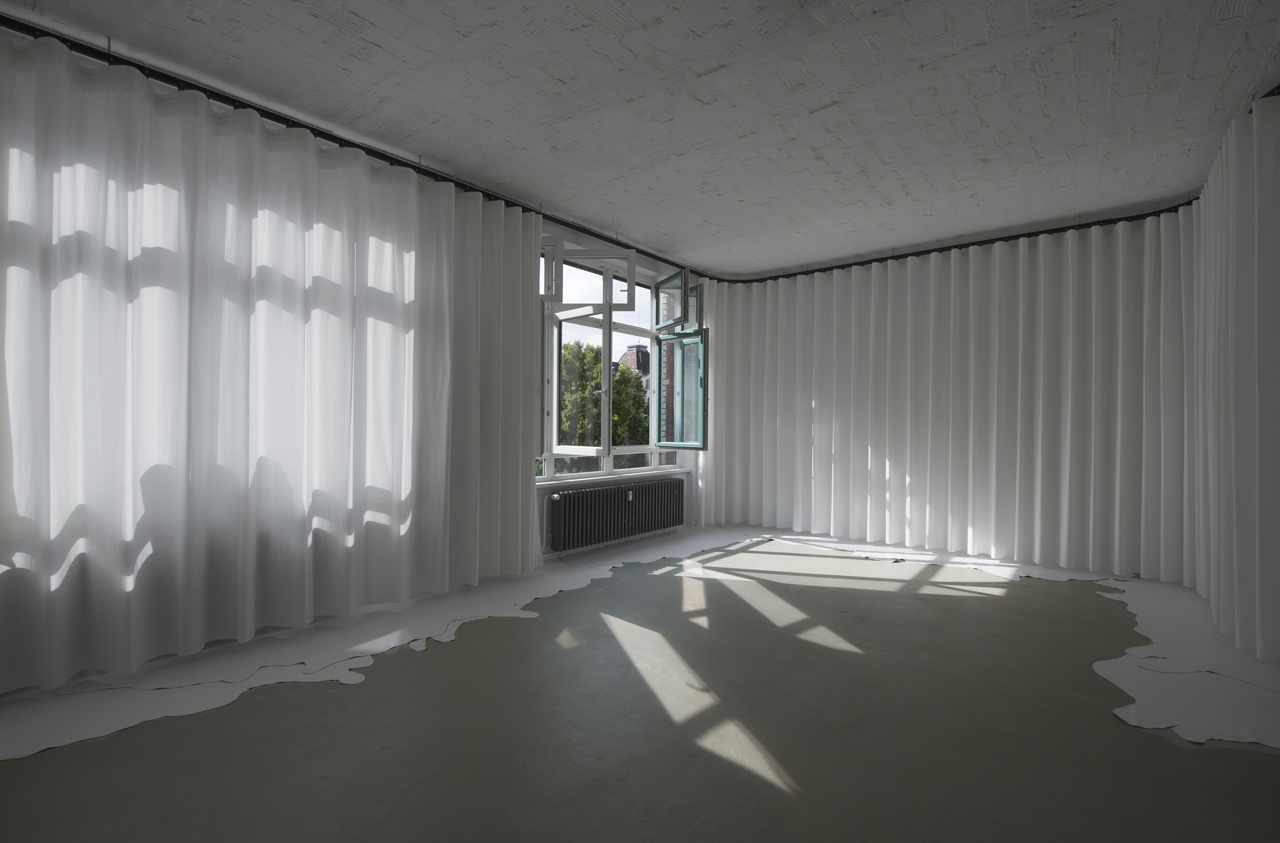SPACE AS SUSPENSION IN TIME Thomas Love on Rindon Johnson at GUTS, Berlin

“Rindon Johnson: Give Chase,” GUTS, Berlin, 2022, installation view
Reflecting on his exhibition “Give Chase,” Rindon Johnson explains that he was in a state of desperation to make a leather floor. But he was also suspicious of his desperation. “Is my desire good for me?” he asks. [1] He was thinking of the leather floor in Joseph Beuys’s studio and the leather ceiling tiles in the cylindrical bathroom of Philip Johnson’s Glass House. One might also think of the leather curtains in Peter Zumthor’s Kolumba museum. In each case, leather suggests how bodies become embroiled in inhospitable systems: the primal scene of Beuys as a wounded soldier wrapped in animal fat, which informs his later self-styling as artist-shepherd; Philip Johnson’s bathroom as the rectal cavity hidden within the modernist fantasy of total transparency; or the sacrificial economy of the Catholic church. Even without hearing Rindon Johnson tell of his conflicted desire, the visitor can sympathize, since the material and aesthetic pleasure of the leather is haunted by the thought of flayed bodies. The poem that serves as the exhibition’s full title references vegan fur and silk pants and asks, “what of the machine, / is it replacing the animal for compassion or because the fragility of the animal / hinders forward locomotion [?]” [2] Between the lines one can hear skepticism about industrialization and narratives of progress premised on the exploitation of human and nonhuman animals alike. One can hear doubts about cruelty-free textiles made from petroleum polymers. Johnson’s uncertainty may be less about what’s good for him and more about what’s good for the planet, a concern so great it’s practically debilitating.

“Rindon Johnson: Give Chase,” GUTS, Berlin, 2022, installation view
“Forward locomotion” is an apt theme for the exhibition as well as its setting. GUTS, as the name implies, is an exhibition space that one passes through. The visitor is first swallowed by the building’s freight elevator before being deposited in a darkened hallway, which takes two turns and culminates in a medium-sized room. GUTS’s distinguishing feature is the 153-meter-long white cotton curtain that covers the hallway and walls, its rhythmic undulations guiding the visitor through the space like peristalsis. In “Give Chase,” Johnson responds to this flowing surface with a line of white cowhides placed on the floor along the edge of the wall. As is common in the leather market, they have come in the form of half hides cut along the spine, and Johnson has installed them with the straight edge against the wall and the irregular edge creeping out across the grey concrete floor almost as if the walls were melting. Lined up neck to rump, they give the effect of a procession – though nothing so spectacular as a running of the bulls. Following one wall all the way down the hallway and around the room, they bridge a gap in the curtain where an open window looks across the courtyard and end under the legs of a custom-made wooden bench that nestles into the corner of the gallery. The viewer is invited to walk upon the cowhides, but there is enough room to bypass them if one is hesitant to scuff their immaculate white surfaces. Their quiet ostinato accompanies the more dramatic dialogue of bench and open window, a Romantic motif suggesting both a longing for and an estrangement from nature. [3]
Throughout his long artistic engagement with leather, Johnson has always highlighted the hide as a site of interaction between body and environment, rather than treating it as the outermost layer of a singular entity. He has tanned his skins with petroleum jelly, or left rawhide to be weathered and hardened by wind and rain, or smeared furniture leather with indigo, coffee, and coconut oil. This is the confrontation of bodies with histories of industrial production, colonial and neocolonial extraction, climate change, and global trade. The idea that the skin is a contested boundary between the individual and the social is quite palpable for a Black, trans artist, and it is part of the lesson Johnson’s work provides to viewers who may or may not share those identities. Furthermore, the leather pieces are in dialogue with a tradition of Black abstract painting. In his book The Law of Large Numbers, Johnson explicitly references Ed Clark, Mary Lovelace O’Neal, and Jack Whitten, and I also see echoes of Sam Gilliam’s draped, stained canvases. [4] These artists demonstrate that the substrate of painting is more than just a surface: it can cover or be covered and it can also absorb and hold. This is especially obvious in the case of skin, since it is an organ specifically suited to these functions. Skin also provides a more direct analogy between the materiality of the artwork and the body of the artist, an analogy that undermines the myth of self-expression by suggesting that the artist is always already marked, while also granting the substrate a resistant agency.

“Rindon Johnson: Give Chase,” GUTS, Berlin, 2022, installation view
But “Give Chase” is atypical for Johnson in that all such marks and traces of agency in the hides have been concealed by their white coating. The hides also appear in greater number, more like a herd than usual, and almost like an irregular unit of measure: the “cowlength.” Their fragmentariness makes abstraction visceral, like when a horse is measured in hands or, perhaps more to the point, like the premonition of the slaughterhouse that comes with measuring a herd of cattle in head. Once again, analogies with the human body are inevitable; indeed, the words “chattel,” “cattle,” and “capital” all stem from the Latin caput, meaning “head,” and it is the instrumental reason at the base of this synecdoche that seems to be under interrogation here. The accumulation of skins and their logical organization brings to mind Katherine McKittrick’s description of “where historic blackness comes from: the list, the breathless numbers, the absolutely economic, the mathematics of the unliving.” [5] In this light, the leather floor evokes the economics of White supremacy and speciesism, linked as they are by a denial of Black humanity.
Nevertheless, the exhibition comes across more like a chapel than a morgue: a site of reflection and temporary respite. Sitting on the bench, one can look diagonally across the gallery and out of the window. Johnson anticipated that this would allow viewers to observe the leaves of the linden trees in the courtyard yellow and fall over the course of the exhibition. The window also opens onto a blank wall stretching the full height of the neighboring building. At certain times of day, the sun reflects off the windows of the building housing the gallery, casting distorted rectangles of light upon this fortuitous projection screen. At the same time, and other times as well (including on overcast days), the artist has reproduced this effect with a pair of mirrors and a bright lamp attached to the outside of the building. There is a tension between the open window’s outlook onto the changing of the seasons and this reflection from an artificial sun that promises pause. It calls to mind the phrase “space as suspension in time,” which appears in Jack Whitten’s notes on the day of Rindon Johnson’s birth. In his book, Johnson responds to Whitten with the notion of “suspension in time by being in time,” which could be a key to the exhibition. [6] If the absence of marks of individuality among the cowhides indicates a movement away from abstract painting, it also heightens the sense of movement between the skins, standardized like stills in a Muybridge study of animal locomotion. The formula “suspension in time by being in time” encapsulates the aporia inherent to the trans desire for an identity at once stable and changeable. As Johnson writes, “[s]ometimes passing for an hour or 20 can save your life but inside here (I mean the ALWAYS here of this book, or this SHOW, or really all realms where a trans address is safe [enough]), we have capping waves … we hover over the cool depths and they pull us downward (and I like it).” [7] This restorative vision transforms the Atlantic ocean from the unmarked grave of the middle passage to a site of pleasurable indeterminacy, a sinking that is also a synching of bodies in different states of difference. [8]

“Rindon Johnson: Give Chase,” GUTS, Berlin, 2022, installation view
The opening of “Give Chase” paralleled the re-opening of Berlin in autumn 2022 in accordance with the diminishing reproduction rate of SARS-CoV-2. The herd of ghostly bodies echoes this tentative attempt to come together again, even as its blank flatness may register the close-minded mantra of the “return to normal” (the white cows could be distant cousins to the white sheep on a poster from May ’68 emblazoned with the slogan “retour à la normale”). The exhibition offers a welcome suspension of such normative temporalities while also acknowledging that suspending time is the new normal within a perpetual state of emergency. I grant Johnson the last word, even if that word is, in his words, “[a] cliché: What frees us binds us and vice versa. Who was it eating? It was full of blood. Well, not anymore. Now its blood is guts. The straightening-out of time.” [9]
“Rindon Johnson: Give Chase,” GUTS, Berlin, August 26–September 25, 2022.
Thomas Love received his PhD in art history from Northwestern University and now teaches at the School of the Art Institute of Chicago. His current book project, titled Queer Exoticism: Strategies of Self-Othering in West Germany, 1969–1994, analyzes artistic and subcultural practices in post-’60s West Germany to show how stereotypes of racial and ethnic difference inform contemporary queer identity.
Image credit: Courtesy of the artist and GUTS art space, photos Charlie B. Click
Notes
| [1] | Rindon Johnson in conversation with the author, September 21, 2022. |
| [2] | Johnson often uses poems in place of titles. In this case, the poem is too long to quote in full, but it can be accessed here. |
| [3] | Lorenz Eitner, “The Open Window and the Storm-Tossed Boat: An Essay on the Iconography of Romanticism” The Art Bulletin 37, no. 4 (1955): 286. An exhibition on the theme was organized by the Metropolitan Museum of Art titled “Rooms with a View: The Open Window in the 19th Century,” April 5–July 4, 2011. |
| [4] | Rindon Johnson, The Law of Large Numbers: Black Sonic Abyss, or I do not walk a line that is thin, straight, or secure (New York: SculptureCenter/Inpatient Press; London: Chisenhale Gallery, 2021). |
| [5] | Katherine McKittrick, “Mathematics of Black Life” Black Scholar 44, no. 2 (Summer 2014): 17. |
| [6] | Johnson, The Law of Large Numbers, 45. |
| [7] | Ibid., 125. |
| [8] | I borrowed this pun from the title of a work of Johnson’s from 2018: They are running together because they sink up together, it feels like they are running slower but they are actually running faster, they are running faster together. |
| [9] | Johnson, The Law of Large Numbers, 205. |
